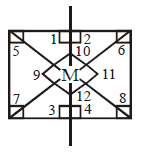351. Arrange the following in increasing order of covalent character - $$NaCl,MgC{l_2},AlC{l_3}.$$
A
$$NaCl < MgC{l_2} < AlC{l_3}$$
B
$$MgC{l_2} < NaCl < AlC{l_3}$$
C
$$AlC{l_3} < MgC{l_2} < NaCl$$
D
$$NaCl < AlC{l_3} < MgC{l_2}$$
Answer :
$$NaCl < MgC{l_2} < AlC{l_3}$$
352. The maximum number of $${90^ \circ }$$ angles between bond pair-bond pair of electrons is observed in
A
$$ds{p^2}$$ hybridization
B
$$s{p^3}d$$ hybridization
C
$$ds{p^3}$$ hybridization
D
$$s{p^3}{d^2}$$ hybridization
Answer :
$$s{p^3}{d^2}$$ hybridization
353. In which of the following pairs of molecules/ions, the central atoms have $$s{p^2}$$ hybridisation?
A
$$NO_2^ - \,{\text{and}}\,N{H_3}$$
B
$$B{F_3}\,{\text{and}}\,NO_2^ - $$
C
$$NH_2^ - \,{\text{and}}\,{H_2}O$$
D
$$B{F_3}\,{\text{and}}\,NH_2^ - $$
Answer :
$$B{F_3}\,{\text{and}}\,NO_2^ - $$
354. Which of the following molecules is formed by $$s{p^2}$$ hybrid orbitals?
A
$$C{H_4}$$
B
$$C{O_2}$$
C
$$B{F_3}$$
D
$$Be{F_2}$$
Answer :
$$B{F_3}$$
355. Which of the following representations of wave functions of molecular orbitals and atomic orbitals is not correct?
A
$${\psi _{MO}} = {\psi _A} \pm {\psi _B}$$
B
$$\sigma = {\psi _A} + {\psi _B}$$
C
$${\sigma ^ * } = {\psi _A} - {\psi _B}$$
D
$${\psi _{MO}} = {\psi _A} \times {\psi _B}$$
Answer :
$${\psi _{MO}} = {\psi _A} \times {\psi _B}$$
356. Which one of the following molecules will form a linear polymeric structure due to hydrogen bonding?
A
$$N{H_3}$$
B
$${H_2}O$$
C
$$HCl$$
D
$$HF$$
Answer :
$$HF$$
357. Which of the following has the minimum bond length?
A
$$O_2^ - $$
B
$$O_2^{2 - }$$
C
$${O_2}$$
D
$$O_2^ + $$
Answer :
$$O_2^ + $$
358. Mark out the incorrect match of shape.
A
$$XeO{F_2} - $$ Trigonal planar
B
$$ICl_4^ - - $$ Square planar
C
$${\left[ {Sb{F_5}} \right]^{2 - }} - $$ Square pyramidal
D
$$NH_2^ - - $$ $$V$$ - shaped
Answer :
$$XeO{F_2} - $$ Trigonal planar
359. The common features among the species $$C{N^ - },CO$$ and $$N{O^ + }$$ are
A
bond order three and isoelectronic
B
bond order three and weak field ligands
C
bond order two and$$\pi $$ —acceptors
D
isoelectronic and weak field ligands
Answer :
bond order three and isoelectronic
360. $$S{F_2},S{F_4}$$ and $$S{F_6}$$ have the hybridisation at sulphur atom respectively as :
A
$$s{p^2},s{p^3},s{p^2}{d^2}$$
B
$$s{p^3},s{p^3},s{p^3}{d^2}$$
C
$$s{p^3},s{p^3}d,s{p^3}{d^2}$$
D
$$s{p^3},sp{d^2},{d^2}s{p^3}$$
Answer :
$$s{p^3},s{p^3}d,s{p^3}{d^2}$$



